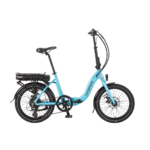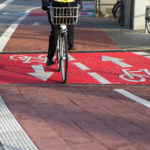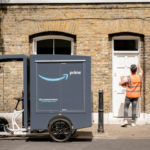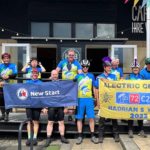I am trying to get my head around how the various systems work. Now my understanding is that with front or rear hub drive the motor is allways on at the various power level selected, and is started or stopped by either pedal movement or a throttle.
With the Panasonic crank drive unit, the power is provided when you start pedalling and the electric power provided to the crank is governed by what power level is selected and is then in direct relation to how hard you actually pedal.
With the Tonaro bevel drive crank system this is similar to the hub drive whereby the power is allways on at the various power levels selected and is started or stopped by either movement of the pedals or the throttle.
So when faced with a hill, with the hub system this can be efficient as long as you can maintain pedalling to keep the bike at the optimum speed for the hub motor, if you cannot then the motor becomes inefficient as the motor will not have sufficient gearing to "torque" you up the hill.
With the Panasonic system the limiting factor is having a low enough gear, as the motors power is always multiplied as you change to lower gears. So the motor can always stay in the sweet spot. Hence this systems ability to defeat nearly any hill you are ever likely to encounter.
With the Tonaro system this is very similar to the Panasonic but without pedal sensing, what i find with the Tonaro is going up a steep hill if i push the pedals hard, then if i tire and back off the motor seems to take over, so that we maintain a similar speed we do not go slower, then if i start pushing on the pedals hard again, the motor eases up and we do not go faster.
Also i have noticed by slowing the cadence on a hill the motor seems to provide more power, is this a function of an electric motor simply providing more torque at a lower RPM? is this why the Panasonic system seems to work best with a lower cadence?
And that by effectively lowering the RPM of the electric motor on a hill, you effectively get "torqued" up the hill by the slow running electric motor? (although you will now have a high amp draw) and that this torque is then multiplied by the gears to stop the motor from stalling.
With a hub system you cannot stop the motor stalling out on a steep hill because it is effectively stalled out by trying to drive too high a gear? Does this explain why hub motors use more electric, because as they come under load as they come out of the motors "sweet spot" the amp draw really shoots up? and there is no way to stop this? Because on a crank drive you can "help" the motor by changing down a gear? and therefore the torque produced by the motor and the cyclist is then multiplied? at the expense of speed.
I am just very interested to know how this all works
With the Panasonic crank drive unit, the power is provided when you start pedalling and the electric power provided to the crank is governed by what power level is selected and is then in direct relation to how hard you actually pedal.
With the Tonaro bevel drive crank system this is similar to the hub drive whereby the power is allways on at the various power levels selected and is started or stopped by either movement of the pedals or the throttle.
So when faced with a hill, with the hub system this can be efficient as long as you can maintain pedalling to keep the bike at the optimum speed for the hub motor, if you cannot then the motor becomes inefficient as the motor will not have sufficient gearing to "torque" you up the hill.
With the Panasonic system the limiting factor is having a low enough gear, as the motors power is always multiplied as you change to lower gears. So the motor can always stay in the sweet spot. Hence this systems ability to defeat nearly any hill you are ever likely to encounter.
With the Tonaro system this is very similar to the Panasonic but without pedal sensing, what i find with the Tonaro is going up a steep hill if i push the pedals hard, then if i tire and back off the motor seems to take over, so that we maintain a similar speed we do not go slower, then if i start pushing on the pedals hard again, the motor eases up and we do not go faster.
Also i have noticed by slowing the cadence on a hill the motor seems to provide more power, is this a function of an electric motor simply providing more torque at a lower RPM? is this why the Panasonic system seems to work best with a lower cadence?
And that by effectively lowering the RPM of the electric motor on a hill, you effectively get "torqued" up the hill by the slow running electric motor? (although you will now have a high amp draw) and that this torque is then multiplied by the gears to stop the motor from stalling.
With a hub system you cannot stop the motor stalling out on a steep hill because it is effectively stalled out by trying to drive too high a gear? Does this explain why hub motors use more electric, because as they come under load as they come out of the motors "sweet spot" the amp draw really shoots up? and there is no way to stop this? Because on a crank drive you can "help" the motor by changing down a gear? and therefore the torque produced by the motor and the cyclist is then multiplied? at the expense of speed.
I am just very interested to know how this all works






